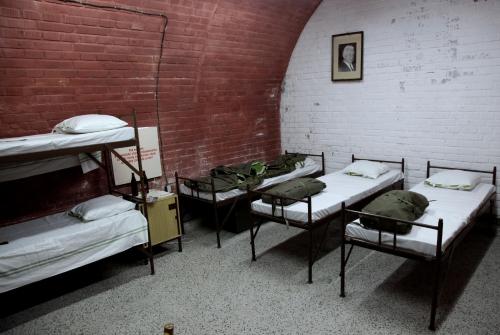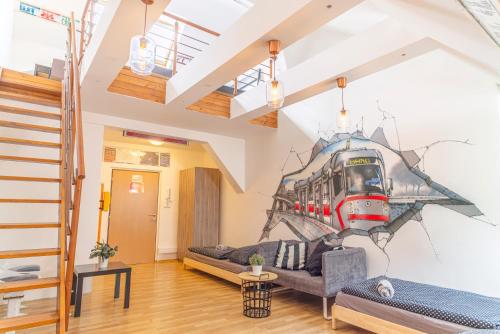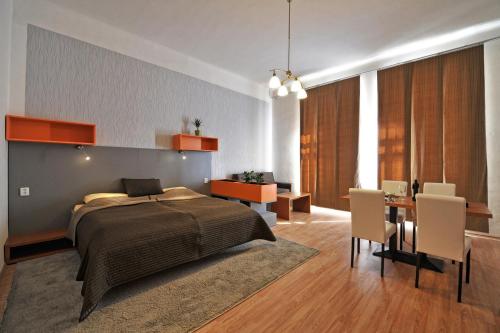I peer inside through the large window that stretches from ceiling to floor, hand up against the glass to try to block out the reflection.
Inside I can see a black circular table with about 15 chairs around it. There’s a curved wooden interior wall behind the table, blocking my view any further in that direction.
Between the window and the table are a few narrow metal columns. Beyond them, I can just make out another collection of furniture.
This is as close as I am going to get to seeing the inside of the Tugendhat Villa this time. I have come all the way to the city of Brno in the Czech Republic to see it… but apparently I should have booked ahead.
As I’ve travelled through the country, one of the things I have tried to do is see all of the Czech World Heritage Sites, as you probably know I like to do. The Tugendhat Villa is one of them.
It’s not that the villa isn’t open – it’s not like the rather annoying privacy at the Stoclet House in Belgium.
In fact, the Tugendhat Villa is open from 10am until 6pm from Tuesday to Sunday. But you can only go in as part of a guided tour and these tours have a limited number of people allowed.
The numbers are so limited and the villa is so popular that it’s recommended you book two months in advance, as soon as tickets are on sale!
There are three types of tours you can take to see different parts of the Tugendhat House and garden – I’ve got all those details later in this article.
Now, to me, this is preposterous. Booking a tour for a particular day and time months in advance might be ok for locals who are interested in seeing the villa but it’s not going to work for most international visitors.
Often, you don’t even know you’re going to be in a particular country that far in advance. And if you do, it’s still unlikely you’ll know that you can definitely be in Brno on that day.
I wonder how many travellers like me have missed out on seeing inside Tugendhat Villa for this reason.
There is some consolation, though. You don’t need to make a reservation to go into the garden at the back of the villa and from here you can get good views of the exterior architecture of the building.
Even from here, you can get a sense of why the Tugendhat Villa is so important and why it was added to the UNESCO World Heritage List.
The history of Tugendhat Villa
The Tugendhat Villa was designed by a German architect called Ludwig Mies van der Rohe for Fritz and Greta Tugendhat (hence the name, obviously).
It was built between 1928 and 1930 and was quite pioneering for its time. What was particularly revolutionary was the use of an iron framework, which meant supporting walls weren’t needed and the interior could be arranged to get a feeling of space and light.
But the building also has an interesting history, beyond just the architectural details.
The Tugendhats abandoned the villa in 1938 because they could see what was happening politically and feared for their lives under Nazi Germany. This began a fascinating ride for the building.
It was claimed by the Gestapo in 1939 and was used for various purposes over the following years – mainly as an office, accommodation and even horse stables for the Soviet military.
It wasn’t until 1967 that Greta Tugendhat was able to return and begin to restore it. From this point on, the villa became a heritage listing and became more visible to the public.
In 1992, it was the setting for one of Europe’s most important modern political events – it was here that the two leaders met to sign the document splitting Czechoslovakia into the Czech Republic and Slovak Republic.
And, for the pop culture geeks among us, it was used as a set in the filming of the movie Hannibal Rising and inspired the novel The Glass Room.
The Tugendhat Villa as a World Heritage Site
The Tugendhat Villa was listed as a World Heritage Site in 2001, because it’s considered to be an outstanding example of the modern movement of architecture that was developing in Europe in the 1920s.
I’ve discussed previously how locations get chosen as World Heritage Sites. They normally need to be the best example of a particular topic – for example, the first, the finest, the most complete.
In the case of the Tugendhat Villa, it wasn’t just one of the first to use a new approach to residential architecture (which became a standard style across the world for decades). It was also one of the most brilliant designs of the time. And it’s been extremely well preserved.
The first most important concept about the Tugendhat House, what made it so different to other residential properties at the time, was the balance between the inside and the outside. Architect Ludwig Mies van der Rohe brought a new philosophy of ‘infinite space’, where the living area didn’t have boundaries, which was intended to reduce anxiety.
Beyond that, the interior design showed a new approach to the living space, using it to its full extent, rather than just a part of it (which had been the norm in Europe until this point). Using new technology to remove internal walls, there was more flow and more room (but fewer rooms).
And the other important concept was furniture and fittings also designed by the architect, at a standard just as high as the building itself. These items were expensive, but not stately. The idea was that everything in the house added to a sense of comfort and superior aesthetics.
Between 2010 and 2012, the villa was restored at a cost of about US$8 million. The idea was to bring it back to its glory, the way it looked in the 1930s, the way Ludwig Mies van der Rohe wanted it, the way the Tugendhats lived in it.
When you visit the Tugendhat Villa these days, this is what you’ll find… if you can see inside, that is.
How to visit the Tugendhat Villa
If you haven’t booked a tour in advance, you are still able to see something at the Tugendhat Villa. During opening hours, you can buy a ticket to go into the garden and look at the building’s exterior. There’s also an exhibition which has some artefacts about the Tugendhat House, plus some of the original furniture.
But, if you want to see inside Tugendhat Villa, you’ll need to book a tour in advance. Tickets go on sale at the start of each month for tours in two months’ time (eg. all the tours for September go on sale on July 1). They often sell out within a day or two.
There are three specific tours that are offered at Tugendhat Villa.
- Basic tour: This 60-minute tour goes through the 3rd floor of the villa and the famous main living room. You also have access to the garden and exhibition rooms
- Extended tour: This 90-minute tour includes everything in the building, and adds a look at the technical floor with things like the air-con machinery room, laundry room, and even the fur coats safe!).
- Villa from the Outside: This 40-minute tour doesn’t go inside the villa but it covers more than just the garden. The focus of the tour is on the terraces on the third and second floors and how they fit into the design.
Unless you have a particular interest in the technical side of things, I would recommend doing the basic tour. However, the extended tour often doesn’t book out quite as quickly, so you may find that’s the only way to visit the villa on the day you want.
Where is the Tugendhat Villa?
The address of Tugendhat Villia is Černopolní 45, 613 00 Brno.
You can see it on a map here.
How do you get to the Tugendhat Villa?
There is no particular public transport stop that services the site. However, there are a lot of bus and tram stops nearby, depending on which direction you’re coming from.
From the main railway station, take tram 9 to Tomanova stop and then go along Tomanova Street.
Can you visit the Tugendhat Villa?
Yes, you can visit the Tugendhat Villa BUT you’ll need to book a tour in advance, and they usually book out two months in advance.
Tickets go on sale at the start of the month for tours in two months, so you might want to be prepared to jump on the website on that. You can book your tickets here.
Tugendhat Villa is open from 9:00 – 17:00 every day except Monday (when it is closed).
How much does it cost to visit the Tugendhat Villa?
The basic tour costs 400 CZK (US$17.40) for adults and 250 CZK (US$10.90) for concessions.
The extended tour costs 450 CZK (US$19.55) for adults and 300 CZK (US$13.05) for concessions.
The Villa from the Outside tour costs 200 CZK (US$8.70) for adults and 150 CZK (US$6.50) for concessions.
Entry to the garden is free.
More information
For more information, you can visit the villa’s official website.
Beyond the Tugendhat Villa, there are lots of other things to do in Brno, a wonderful Czech city that doesn’t get nearly as much attention as it should. I would recommend staying for a few nights and exploring the sights and the surrounding region.
THE BEST ACCOMMODATION IN BRNO
Brno is a big city with a wide range of accommodation. You may find it easier to stay near the main train station for transport.
BACKPACKER

If you’re looking for a budget option, the 10-Z Bunker hostel is pretty cool because it’s in an old bunker!
BUDGET

For something affordable but trendy, Internesto Apartments Downtown is a great place.
BOUTIQUE

For a cool and stylish option, you should try Apartmánový Dům Centrum.
LUXURY
And if you want to splurge for somewhere really fancy, have a look at the Barceló Brno Palace.
Great blog and I really enjoy following along, as I am also a long-term traveler trying to visit as many UNESCO sites as humanly possible. This happened to me when I made a day trip to Utrecht, Netherlands, to see the Rietveld Schröder House (http://www.myradiantcity.com/blog/2017/3/16/sights-sounds-in-utrecht), although reservations didn’t have to be made a month out. Very frustrating indeed, but you got some beautiful photos.
Yeah, I always have trouble at places where you need to make reservations because I don’t normally know what I’m doing until the day I get there! 🙂
I was able to get into the Rietveld Schroder House and it was pretty cool to see the way it all fits together. I hope you get a chance to go back one day and see it for yourself.